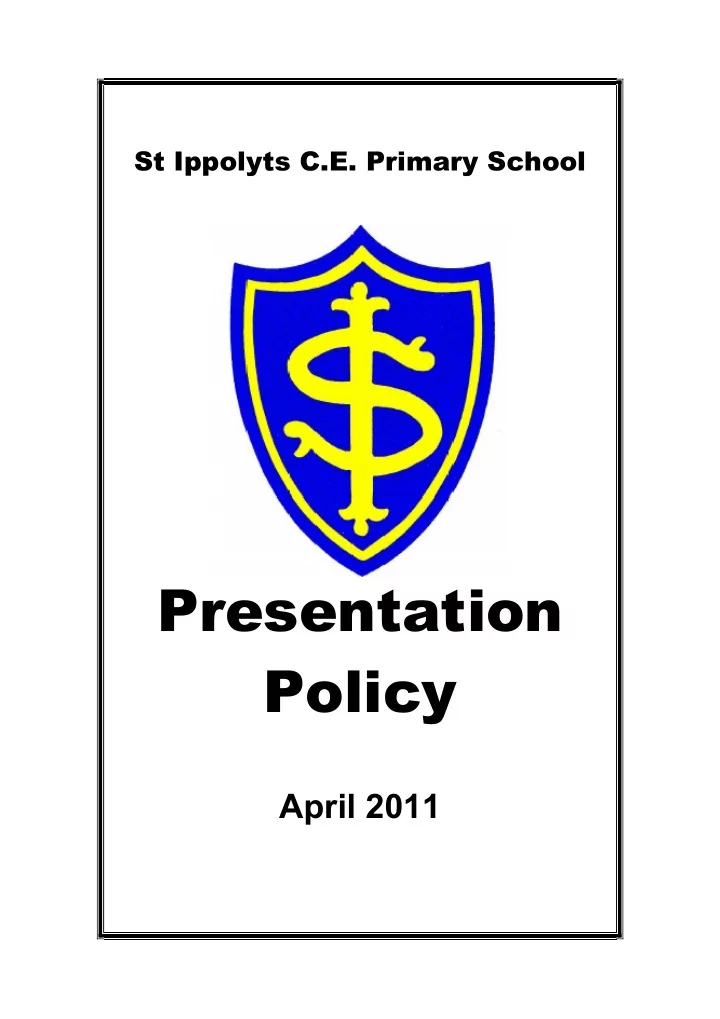

St Ippolyts C.E. Primary School Presentation Policy April 2011
ST IPPOLYTS CE (AIDED) PRIMARY SCHOOL PRESENTATION POLICY April 2011 INTRODUCTION The purpose of this policy is to produce a consistent approach towards the presentation of work throughout the school. Children should all be aware of the standards expected of them and know that this will apply whichever teacher is taking the class. It will ensure expectations are raised by all staff and engender in all children a sense of pride in how their work should look. GENERAL POINTS Both sides of the paper should be written on and each page filled before turning to the next. Each piece of work must be dated on the left. As a model for this the teacher must write the date on the board. The short version of the date in the format dd/mm/yy is to be used in Maths books, but the long version in all other subjects. Children should know how to spell the days of the week and months of the year. The date should be underlined using a ruler and pencil. Each piece of work should have a title modelled on the board by the teacher. This could be the objective for the task and should be started on the left hand side under the date and underlined in pencil using a ruler. Children will write on every line. The only exception to this may be during a creative/extended writing activity where teachers may need the space to correct any errors clearly or where the child may need the space to re-draft and/or include new ideas. The end of one piece of work must be clearly shown by a line drawn across the page under any previous writing, including any teacher’s comments. This must be drawn with pencil and a ruler using the lines already printed on the page as a guide and must be done before the book is used again. A new page should only be used if there are less than ¼ of the page left. In Key Stage 2, lined exercise books that do not already have a printed margin must have a pencil margin drawn down the left hand side of every page, which is a consistent width, i.e. the width of the ruler. If the work consists of diagrams or pictures, it must be done on a sheet of A4 paper which should be trimmed and stuck in neatly. Any mistakes should be crossed out neatly using one ruled line . The correct version should be written on the same line or above the mistake, wherever is most appropriate.
Tippex or pen erasers are not allowed. Rubbers should be used sparingly as they can make more mess by smudging the page. The use of pen or pencil is determined by the guidelines set out in the handwriting policy. Children use pen when awarded the ‘pen permit’ in Class 3. Only blue ink may be used in exercise books. School handwriting pens only should be used except in Year 6 where a Fountain Pen Pemit may be awarded. Work for displays around the school should be written as a “best copy” in pen for KS2 and in pencil for KS1. A child should not write or draw anything on the covers of any exercise books.vA child should not ”doodle” or in any other way mark any of the pages in their exercise books. Felt tip pens and gel pens should not be used in any exercise books. Colouring pencils only should be used to colour in. Drawings or diagrams must be done in pencil and straight lines drawn with a ruler unless it is intended to be a rough sketch. The use of worksheets should be minimal, but where necessary they should be trimmed and stuck into books neatly. Excellent presentation is recognised and rewarded through stickers, team points, the ‘presentation badge’ and through display on the Presentation Gallery. These expectations for standards of presentation apply to homework as well as school based learning. SUBJECT SPECIFIC POINTS English Question numbers should be recorded in the margins. Mathematics Numeracy work is to be recorded in pencil. A title may be a text book heading and page reference number. ALL lines should be drawn with a pencil and ruler; this includes answer lines for vertical sums, tables, graphs and all straight sided shapes. For those children using squared pages, each digit should be written in a separate box to assist with understanding place value. All question numbers should be noted and shown by a bracket, e.g. 2) as dots can be confused with decimal points. Any corrections should be written out again as a new sum, rather than being altered on the original sum. Science Rulers must be used for any diagrams that need straight sides represented. All diagrams and lines to label parts must be drawn in pencil but written labels can be written in ink if appropriate.
Any colouring should be done using colouring pencils. All lined pages must have a neat, pencil drawn margin on the left hand side, if not already printed History / Geography /R.E. All diagrams and maps should be drawn in pencil. Only colouring pencils to be used. Cross reference to Marking and Feedback Policy
Recommend
More recommend